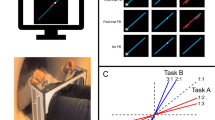Abstract.
Positron emission tomography (PET) was used to examine changes in the cerebellum as subjects learned to make movements with their right arm while holding the handle of a robot that produced a force field. Brain images were acquired during learning and then during recall at 2 and 4 weeks. We also acquired images during a control task where the force field was not learnable and subjects did not show any improvements across sessions. During the 1st day, we observed that motor errors decreased from the control condition to the learning condition. However, regional cerebral blood flow (rCBF) in the posterior region of the right cerebellar cortex initially increased from the control condition and then gradually declined with reductions in motor error. Correspondingly, rCBF in the ipsilateral deep cerebellar nuclei (DCN) initially decreased from the control condition and then increased with reductions in motor error. If measures of rCBF mainly reflect presynaptic activity of neurons, this result predicts that DCN neurons fire with a pattern that starts high in the control task then decreases as learning proceeds. Similarly, Purkinje cells should generally have their lowest activity in the control task. This pattern is consistent with neurophysiological recordings that find that cerebellar activity during early learning of a motor task may mainly reflect changes in coactivation of muscles of the limbs, rather than a learning specific signal. By the end of the first session, motor errors had reached a minimum and no further improvements were observed. However, across the weeks a region in the anterior cerebellar cortex showed gradual decreases in rCBF that could not be attributed to changes in motor performance. Because patterns of rCBF in the cortex and nuclei were highly anti-correlated, we used structural equation modeling to estimate how synaptic activity in the cerebellar cortex influenced synaptic activity in the DCN. We found a negative correlation with a strength that significantly increased during the 4 weeks. This suggests that, during long-term recall, the same input to the cerebellar cortex would produce less synaptic activity at the DCN, possibly because of reduced cerebellar cortex output to the DCN.
Similar content being viewed by others
Author information
Authors and Affiliations
Additional information
Electronic Publication
Rights and permissions
About this article
Cite this article
Nezafat, R., Shadmehr, R. & Holcomb, H.H. Long-term adaptation to dynamics of reaching movements: a PET study. Exp Brain Res 140, 66–76 (2001). https://doi.org/10.1007/s002210100787
Received:
Accepted:
Issue Date:
DOI: https://doi.org/10.1007/s002210100787




